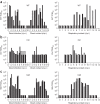MicroRNA-based strategy to mitigate the risk of gain-of-function influenza studies
- PMID: 23934176
- PMCID: PMC3808852
- DOI: 10.1038/nbt.2666
MicroRNA-based strategy to mitigate the risk of gain-of-function influenza studies
Abstract
Recent gain-of-function studies in influenza A virus H5N1 strains revealed that as few as three-amino-acid changes in the hemagglutinin protein confer the capacity for viral transmission between ferrets. As transmission between ferrets is considered a surrogate indicator of transmissibility between humans, these studies raised concerns about the risks of gain-of-function influenza A virus research. Here we present an approach to strengthen the biosafety of gain-of-function influenza experiments. We exploit species-specific endogenous small RNAs to restrict influenza A virus tropism. In particular, we found that the microRNA miR-192 was expressed in primary human respiratory tract epithelial cells as well as in mouse lungs but absent from the ferret respiratory tract. Incorporation of miR-192 target sites into influenza A virus did not prevent influenza replication and transmissibility in ferrets, but did attenuate influenza pathogenicity in mice. This molecular biocontainment approach should be applicable beyond influenza A virus to minimize the risk of experiments involving other pathogenic viruses.
Conflict of interest statement
The authors declare no competing financial interests.
Figures




References
-
- Palese, P. & Shaw, M.L. Orthomyxoviridae: the viruses and their replication. in Fields Virology (eds. Knipe, D.M. et al.) 1647–1690 (Lippincott Willams & Wilkins, 2007).
Publication types
MeSH terms
Substances
Grants and funding
LinkOut - more resources
Full Text Sources
Other Literature Sources
Medical
Research Materials

